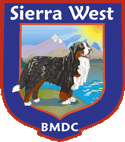
and herding
|
|
Bernese and herding |
| INSIDE | |
| About the breed |
Bernese are upright herders. They are loose-eyed, but exhibit all the skills that make an excellent stock dog. This means they move stock while standing up, unlike the typical stalking herding style of a Border
Collie or Australian Kelpie.
Bernese don't have the tight "eye" of the Collie or Kelpie, who use their unwavering predators' stare for control. Natural herding ability is a vital component of the herding dog. It is difficult to mechanically train a dog who has little instinct. The instinct has to be there, to be refined and guided by training. Learning to trust that instinct is as important as learning "away to me" or "go by."
Most herding dogs are gatherers. This means they naturally run out to the head of the flock, group it, and move it toward the handler. Some are trained drivers, who also try to keep the stock grouped but move the stock away from the handler. Bernese, sometimes mistakenly thought of as drivers, in actuality have strong gathering instinct. Wearing, or moving side to side behind the stock to keep them grouped and balanced to the handler, is also fully present in today's Berner.
Bernese are recognized by the American Herding Breeds Association as a herding breed. The AHBA offers herding trials to test your dogs skills. They offer titles from beginning (Herding Capability Tested) to advanced. Currently, the Bernese Mountain Dog Club of America recognizes the second level offered by the AHBA, the JHD, as qualifying for the Versatilty title and the Working Dog title.
The JHD test uses three obstacles: two panels at the far end of each corner of the arena and one centered
panel, all with 12-footopenings. The handler and dog must go around one obstacle (panel) move across to the other and then proceed through the center opening. (This can also be done in reverse order.) The dog must then be stopped, the holding pen opened and the sheep moved into the pen and the gate closed. The dog must not follow the sheep into the pen. There is a time limit of 8 minutes.
The best way to begin is to work with an experienced herding trainer. The trainer will be able to provide individual attention and instruction suited to your particular dog. The stock and the facility should be suitable for beginners as well as for those who have more experience. The lessons aren't necessarily private lessons held in one block of time, but usually involve several short sessions interspersed with rest periods. While the dog is taking a break, the owner can learn by watching other dogs being trained and can visit with other participants.
It's very important to make sure the trainer is experienced with many breeds of herding dogs. The Bernese herds differently than a Border Collie as they are upright (they do not "stalk") and loose-eyed (they do not fix their eyes on the livestock.) They also work very close. Training the Bernese style of herding requires a different set of techniques.
Although individual lessons are best, clinics can be very helpful, being fairly similar to private lessons but providing a broad overview of dogs in various stages of training. Some people get their initial start by having their dog take part in an organized herding instinct test. Instinct tests focus primarily on the beginning step of the first introduction of the dog to stock, but while they should be held in the setting of a clinic, often there is not time for very much individual attention. There are both all-breed tests and tests held by breed clubs for their own breed.
Many books have been written about herding, but few mention the Bernese. Here are some good ones:
|